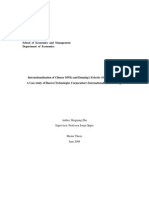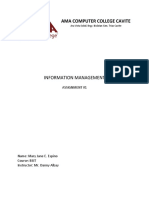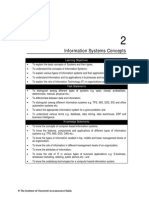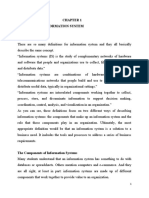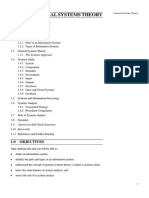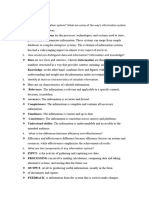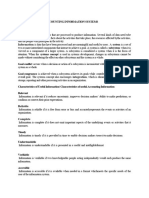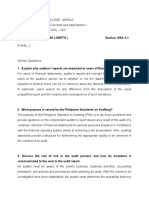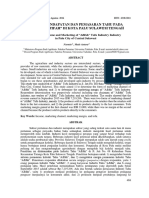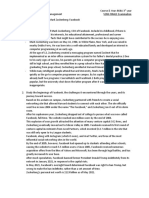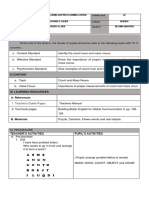NAME: LORENZO, Diane Loreto I
NAME: LORENZO, Diane Loreto I
Uploaded by
Diane LorenzoCopyright:
Available Formats
NAME: LORENZO, Diane Loreto I
NAME: LORENZO, Diane Loreto I
Uploaded by
Diane LorenzoOriginal Title
Copyright
Available Formats
Share this document
Did you find this document useful?
Is this content inappropriate?
Copyright:
Available Formats
NAME: LORENZO, Diane Loreto I
NAME: LORENZO, Diane Loreto I
Uploaded by
Diane LorenzoCopyright:
Available Formats
NAME: LORENZO, Diane Loreto I.
BS ACCOUNTANCY 2-1
IT APPLICATION TOOLS IN BUSINESS
SEATWORK NO. 1
Understanding information systems and their role in the organization
For us to understand information systems and its role, we first define a system. A system is a set of rules,
arrangement of items or a group of related things that works toward a common objective or goal. According to
James Hall, in his book Accounting Information Systems 7 th edition, the term system is broad and widely applicable.
Certain systems occur naturally, while others are artificial. Natural systems range from the atom— the system of
electrons, protons, and neutrons— to the universe— the system of galaxies, stars, and planets. Examples of natural
systems are all life forms, plant and animals. Artificial systems are particularly man-made. These systems range from
clocks to submarines and social systems to information system.
Information system is an integrated set of components for the collection, storage and processing of data
and the provision of information, knowledge and digital products. Typically, information systems include a mix of
software, hardware and telecommunications networks. Business companies and other organizations depend on
information systems to carry out and handle their activities, communicate with their clients and vendors and
collaborate on the marketplace. Information systems are used to operate inter-organizational supply chains and the
markets of electronics. Corporations, for example, use information systems to process financial accounts, handle their
human resources, and with online promotions reach their prospective clients.
Clearly from its definition, we can see through it its importance to an organization particularly business. To
further elaborate its essence, we can turn to its role in the organization. Organizations across all sectors can
manipulate information technology to create smarter choices in order to meet objectives more effectively. Today, we
have access to state-of - the-art software that enables us to enhance customer care, transform big data into useful
ideas, evaluate hazards, and enhance company safety. How this technology will be used depends on your objectives.
One role of information system to an organization is that it offers many advantages. It has the ability to
process complex data that greatly helps in making important and strategic decisions for the organization. It is
possible to identify several functions performed by an organization's information systems, but O'Brien and Marakas
(2008) recognized three basic functions performed by business information systems. These are; First, information
systems help activities and business processes. Secondly, they promote staff and executives ' decision-making and,
finally, they promote competitive advantage policies.
Organizations that fully understand how information system and technology works have a competitive edge.
In this digital era, with the contact of a click, we can swap huge quantities of information in seconds, conduct
video conferences and system transfers. Indeed, information system plays a vital role in meeting the goals of an
organization.
Information Life Cycle
What exactly is information? Information, by definition, is knowledge of a specific topic, problem,
occurrence or method. An information goes by a process of usage. This is called its life. The life of an information is a
repetitive sequence of events. It works like just how rain is formed, water evaporates from the surface of the earth,
rises into the atmosphere, cools and condenses into rain or snow in clouds, and falls again to the surface as
precipitation. Thus, it’s a cycle where it repeats a pattern.
The information life cycle is a stage through which each file of facts or information passes from being
created to being finally archived or destroyed.
The information life cycle has five phases.
(1) INFORMATION CAPTURE – Data reaches an organization by data capture. This pertains to data entry and
data reception which means the stage where an information is on the way to its production. When data joins your
organization, the information lives process begins. This data will provide useful and actionable information for your
company once connected to other data in your information systems.
(2) DATA STORAGE – The data that the organization captured needs to be stored diligently. Data must be
collected and guaranteed in an ideal way to minimize space demands and data should be stored in a categorized
manner for easier access. It is quite difficult to hold the different kinds of big data that the company acquires,
produces and gets from instruments that need to be maintained to be used for retrieval and publication later.
(3) UTILIZATION – The stage where how a data is used. Once data is collected safely and accessible, analytical
procedures can be developed to produce actionable information that can be internally circulated for an organization’s
decision making. The data gathered, stored, categorized and edited is used wisely for publication. Each organization
releases its data to its stakeholders including staff, suppliers, and shareholders. Organizations use many tools to
publish and report information. Data sharing is also part of the publication, as the purpose of publishing data is to
make it available to the intended audience.
(4) ARCHIVING - Another significant phase of the information life cycle is data archiving. When bulk of data is
process on a regular basis, it results to extremely costly storage and handling which means slowing down of the
publication of the information. To counteract this, information is regularly verified, edited and archived because there
are data that are no longer needed for current operations but is still useful for analysis and reporting.
(5) REMOVING DATA (DATA PURGE)– This is the end phase of the life cycle. If data has served its usefulness to
your organization and is no longer needed for regulatory purposes and concerns, removing it from the information
systems is important since the goal is always to keep optimum access to helpful information.
Information is an organization's most precious asset and it is essential to ensure that it stays safe at all
stages of its lives straight up to the end of use. In conclusion, understanding the information life cycle will enable us
to open our minds as to how we use our information efficiently for effective outcomes.
You might also like
- The Role of Information Systems in An OrganizationDocument27 pagesThe Role of Information Systems in An OrganizationChow Dhury100% (4)
- Downloadable Solution Manual For Information Technology Auditing 3rd Edition James Hall Solutions 1Document4 pagesDownloadable Solution Manual For Information Technology Auditing 3rd Edition James Hall Solutions 1Diane Lorenzo0% (1)
- CC104 Lect1Document15 pagesCC104 Lect1Judy Mae FloresNo ratings yet
- Mis NotesDocument32 pagesMis Noteskalvic123211No ratings yet
- IAN - Reinsurance: 1 When Is IFRS 17 Used To Reinsurance Contracts ?Document15 pagesIAN - Reinsurance: 1 When Is IFRS 17 Used To Reinsurance Contracts ?Diane LorenzoNo ratings yet
- HuaweiDocument78 pagesHuaweiAkumarc Kumar100% (2)
- Art and Design: Inside Listening and Speaking 3 Unit 3 Answer KeyDocument6 pagesArt and Design: Inside Listening and Speaking 3 Unit 3 Answer KeyLâm Duy0% (2)
- B40 Dev Call For Proposal FormatDocument11 pagesB40 Dev Call For Proposal FormatDayana CNo ratings yet
- Math DLP 021419 CotDocument2 pagesMath DLP 021419 CotMark neil a. GalutNo ratings yet
- MIS Unit 1Document51 pagesMIS Unit 1ArchitNo ratings yet
- Chapter 2 Only Dissertation.Document24 pagesChapter 2 Only Dissertation.calebtadiwaNo ratings yet
- Management Information SystemsDocument65 pagesManagement Information SystemsKirui Bore PaulNo ratings yet
- Mis Management Information SystemsDocument17 pagesMis Management Information Systemskawther.gheribNo ratings yet
- Bsba LS Mis N01Document5 pagesBsba LS Mis N01mecycastillomjNo ratings yet
- Management Information System (Part 1)Document3 pagesManagement Information System (Part 1)michael ladaNo ratings yet
- Ama Computer College Cavite: Information ManagementDocument11 pagesAma Computer College Cavite: Information ManagementMary Jane Evardone EspinoNo ratings yet
- Marketing Information Chapter OneDocument11 pagesMarketing Information Chapter OnehenokNo ratings yet
- Information SystemDocument9 pagesInformation SystemMuskaan TayalNo ratings yet
- Ldit 2114 Information Policy, Strategies and Systems Lesson 1Document20 pagesLdit 2114 Information Policy, Strategies and Systems Lesson 1JamesNo ratings yet
- What Is Information SystemDocument2 pagesWhat Is Information SystemGrace FuentesNo ratings yet
- Information System: Decision-MakingDocument9 pagesInformation System: Decision-MakingMAYANK SINGH IET Lucknow StudentNo ratings yet
- DEVELOP & Manage Information System Un EditedDocument23 pagesDEVELOP & Manage Information System Un EditedFelekePhiliphosNo ratings yet
- IM I Unit NotesDocument39 pagesIM I Unit Notesshaik.712239No ratings yet
- Management of Information System and ServiceDocument33 pagesManagement of Information System and Servicekennedy kipkorir kosgeiNo ratings yet
- Isca 2nd ChapterDocument41 pagesIsca 2nd ChapterCA Shivang SoniNo ratings yet
- 01 - Introduction To Accounting Information Systems (Notes)Document6 pages01 - Introduction To Accounting Information Systems (Notes)Ralph CastrolNo ratings yet
- MIS Module 5 FDocument16 pagesMIS Module 5 FwuikesweetyNo ratings yet
- Basic Concepts of Management Information System: Because It FacilitatesDocument35 pagesBasic Concepts of Management Information System: Because It FacilitatesGuteNo ratings yet
- Basic Conceptsof Information Systemsfrom Contemporary Issuesin Information SystemsDocument19 pagesBasic Conceptsof Information Systemsfrom Contemporary Issuesin Information SystemsaissiNo ratings yet
- Three Primary Uses of Information SystemsDocument5 pagesThree Primary Uses of Information SystemsInnoe malon Machinga100% (1)
- MIS ImprovedDocument122 pagesMIS ImprovedEBUBENo ratings yet
- Mis 3Document16 pagesMis 3ISAAC SICHALWENo ratings yet
- 2016 AIS Chapter OneDocument11 pages2016 AIS Chapter OneGetaneh YenealemNo ratings yet
- 3.2.2 Implications For System DesignDocument34 pages3.2.2 Implications For System DesignppghoshinNo ratings yet
- BDBMS QBDocument96 pagesBDBMS QBAmanda BarkerNo ratings yet
- Information System (Is)Document27 pagesInformation System (Is)Pooja RaiNo ratings yet
- CS270 Chapter 1Document11 pagesCS270 Chapter 1JOELNo ratings yet
- INformstion SystemsDocument20 pagesINformstion SystemsvikeeeeeNo ratings yet
- Business Information System: Department of Management Admas UniversityDocument28 pagesBusiness Information System: Department of Management Admas UniversitytesfaNo ratings yet
- Foundations of Information SystemsDocument19 pagesFoundations of Information SystemsMahnoor AzharNo ratings yet
- Cyber Security Notes UNIT-IDocument41 pagesCyber Security Notes UNIT-IShalini VermaNo ratings yet
- The Basic Concepts of Information Systems: July 2021Document19 pagesThe Basic Concepts of Information Systems: July 2021Agus TriadiNo ratings yet
- REVIEW QUESTION - Docx JennyDocument5 pagesREVIEW QUESTION - Docx JennyhirayafranciffNo ratings yet
- UCI 202 Topic 1 NotesDocument11 pagesUCI 202 Topic 1 Notesaroridouglas880No ratings yet
- Introduction To Information SystemsDocument5 pagesIntroduction To Information SystemsGwelambertNo ratings yet
- Lesson One MisDocument13 pagesLesson One MissolocheruicNo ratings yet
- Lecture Notes: What Is Data?Document4 pagesLecture Notes: What Is Data?Jazzd Sy Gregorio100% (1)
- Chapter-1: Information SystemDocument42 pagesChapter-1: Information SystemSaiful Islam TareqNo ratings yet
- Information System (IS) Is The Study of Complementary Networks of Hardware and SoftwareDocument9 pagesInformation System (IS) Is The Study of Complementary Networks of Hardware and SoftwareRashi GurnaniNo ratings yet
- Information Systems - ReadingDocument23 pagesInformation Systems - ReadingAlejandro Rios MorenoNo ratings yet
- Information System Security Dit 3 VVVVVDocument19 pagesInformation System Security Dit 3 VVVVVfeisalNo ratings yet
- I.T AssignmentDocument22 pagesI.T AssignmentShaheer ShaikhNo ratings yet
- Erp Unit 1Document7 pagesErp Unit 1ankitjangirldhNo ratings yet
- I Unit NotesDocument38 pagesI Unit Notesshaik.712239No ratings yet
- Project Management Information SystemDocument57 pagesProject Management Information Systemallan kiplimoNo ratings yet
- Module 1 Bsais3b GasconalyssamarieDocument10 pagesModule 1 Bsais3b GasconalyssamarieAlyssaNo ratings yet
- C Information Systemapplication Landscape: Aa SYSDocument6 pagesC Information Systemapplication Landscape: Aa SYSghuk_007No ratings yet
- Foundation of ICT Lec2 (Autosaved)Document9 pagesFoundation of ICT Lec2 (Autosaved)KOMBA JOSEPH MONDEHNo ratings yet
- Management Information SystemDocument27 pagesManagement Information SystemWeng Garrote EvangelistaNo ratings yet
- Information System Defining Information SystemsDocument27 pagesInformation System Defining Information SystemsFidelis GodwinNo ratings yet
- Data, Information, Characteristics of Useful InformationDocument2 pagesData, Information, Characteristics of Useful Informationemmanuel.n.ablorh05No ratings yet
- It 1Document19 pagesIt 1Lyka renaNo ratings yet
- Information SystemDocument8 pagesInformation SystemMUNEEBA GULNo ratings yet
- Factors Influencing Students Career Choices Empirical Evidence From Business StudentsDocument16 pagesFactors Influencing Students Career Choices Empirical Evidence From Business StudentsBianca Marie Uypala ErquilangNo ratings yet
- XXX AT ExxM ACTIVITYDocument2 pagesXXX AT ExxM ACTIVITYDiane LorenzoNo ratings yet
- Ancient Civilizations Primary Sources ConfuciusDocument1 pageAncient Civilizations Primary Sources ConfuciusDiane LorenzoNo ratings yet
- Attendance at Physical Inventory CountinDocument3 pagesAttendance at Physical Inventory CountinDiane LorenzoNo ratings yet
- Activity PPEDocument6 pagesActivity PPEDiane LorenzoNo ratings yet
- Ci June 03 p26 PDFDocument1 pageCi June 03 p26 PDFDiane LorenzoNo ratings yet
- Figure 1.1 An Illustration of The Five Phases of The Information Life CycleDocument1 pageFigure 1.1 An Illustration of The Five Phases of The Information Life CycleDiane LorenzoNo ratings yet
- SelectionDocument76 pagesSelectionDiane LorenzoNo ratings yet
- Requirements: Determine The Following: 1. Range 2. Class Size 3. Class Boundary 4. Complete This Table Class Interval Class Boundaries FDocument2 pagesRequirements: Determine The Following: 1. Range 2. Class Size 3. Class Boundary 4. Complete This Table Class Interval Class Boundaries FDiane LorenzoNo ratings yet
- RIZALDocument3 pagesRIZALDiane LorenzoNo ratings yet
- BSA 3101 Topic 3C - Franchise Accounting v2Document4 pagesBSA 3101 Topic 3C - Franchise Accounting v2Diane LorenzoNo ratings yet
- Reviewer ObliconDocument2 pagesReviewer ObliconDiane LorenzoNo ratings yet
- Art-App - Painting ReflectionDocument8 pagesArt-App - Painting ReflectionDiane LorenzoNo ratings yet
- Akif BSDocument32 pagesAkif BSNaflaNo ratings yet
- Portraiture. Facing The Subject PDFDocument48 pagesPortraiture. Facing The Subject PDFErnestina Karystinaiou EythymiatouNo ratings yet
- TRACER STUDY OF RTU Graduates AN AnalysisDocument12 pagesTRACER STUDY OF RTU Graduates AN AnalysisMaorin SantosNo ratings yet
- The Role of Computer Games in Enhancing Primary School Students Attitude Towards MathematicsDocument7 pagesThe Role of Computer Games in Enhancing Primary School Students Attitude Towards MathematicsIJAR JOURNALNo ratings yet
- Human Resource Management: Tech Mahindra Ltd. Training & Performance AppraisalDocument25 pagesHuman Resource Management: Tech Mahindra Ltd. Training & Performance AppraisalAarushiNo ratings yet
- Analisis Pendapatan Dan Pemasaran Tahu P 28b9305bDocument11 pagesAnalisis Pendapatan Dan Pemasaran Tahu P 28b9305breinaNo ratings yet
- World Greatest Strategists - Mark Zuckerberg of FacebookDocument2 pagesWorld Greatest Strategists - Mark Zuckerberg of Facebookjojie dador100% (1)
- PA1903 Module Guide PDFDocument11 pagesPA1903 Module Guide PDFLuis Carlos RodriguesNo ratings yet
- Philanthropy and CSRDocument3 pagesPhilanthropy and CSRimjiyaNo ratings yet
- Impact Assessment of NGPDocument100 pagesImpact Assessment of NGPElsa Alabado-OrtegaNo ratings yet
- Ergonomics and Facilities Planning For The Hospitality IndustryDocument10 pagesErgonomics and Facilities Planning For The Hospitality IndustryJian Miee Rama LequironNo ratings yet
- Polytechnic University of The PhilippinesDocument11 pagesPolytechnic University of The PhilippinesBianca CabaliNo ratings yet
- Chris Aubeck - Desperately Seeking RudolphDocument16 pagesChris Aubeck - Desperately Seeking RudolphPeon100% (2)
- FOME Team, Teamwork & LeadershipDocument30 pagesFOME Team, Teamwork & LeadershipNixy ClaudiaNo ratings yet
- Chapter 2 The Development of EspDocument4 pagesChapter 2 The Development of EspK wong100% (1)
- 40 Aldrin Jeff Cudia vs. Superintendent of PMA PDFDocument4 pages40 Aldrin Jeff Cudia vs. Superintendent of PMA PDFKJPL_1987No ratings yet
- Māori Business ConceptsDocument10 pagesMāori Business ConceptsAriana CalixtoNo ratings yet
- Employment Newspaper Fourth Week of March 2019 PDFDocument32 pagesEmployment Newspaper Fourth Week of March 2019 PDFsundharNo ratings yet
- The Middle Ages (History of Weapons and Warfare)Document120 pagesThe Middle Ages (History of Weapons and Warfare)Octav Adrian Butoescu100% (4)
- 1965 - Normal Crimes, Sociological Features of The Penal Code in A Public Defender OfficeDocument23 pages1965 - Normal Crimes, Sociological Features of The Penal Code in A Public Defender OfficeRowena BrionesNo ratings yet
- Star Wards PDFDocument357 pagesStar Wards PDFmana100% (3)
- PSM Veena Project 19-20 - 1Document69 pagesPSM Veena Project 19-20 - 1Atul KumarNo ratings yet
- Memory Aid LABORDocument70 pagesMemory Aid LABORShila Tabanao VisitacionNo ratings yet
- Illinois V CaballesDocument2 pagesIllinois V CaballesCharisse Christianne Yu CabanlitNo ratings yet
- SchoodemoDocument6 pagesSchoodemomary roseNo ratings yet
- Improving The Efficiency of Engines For Large Non Fighter AircraftDocument193 pagesImproving The Efficiency of Engines For Large Non Fighter AircraftmadjadNo ratings yet






